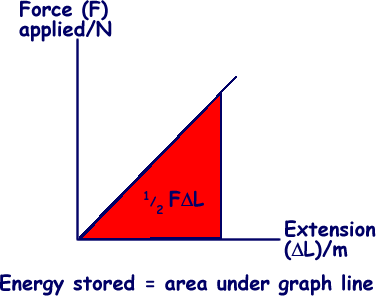    |
||||

Elastic Energy |
||||
|
Elastic Potential
Energy (sometimes called 'stretch or compressed' potential energy)
is found in springs, elastic materials (balls and bands). It comes from
the structure of the materials and their desire to retain a particular
shape. It can be used as a store for energy (hence the word 'potential'). The energy stored is the area under a force/extension graph line.
Elastic Behaviour When a material is
stretched (or compressed) but returns to its original size when the load
is removed, it undergoes elastic behaviour. Elastic bands are a good example
of this although most materials exhibit elastic behaviour to some extent. When a material is stretched (or compressed) but does not return to its original size when the load is removed, it undergoes plastic behaviour. Atoms that make up a material are arranged in a particular way - when you compress or stretch a material with enough force to alter this arrangement you make the object experience plastic behaviour. You permanently deform the material. Hooke's Law says that the restoring force due to a stretched (or compressed) spring is proportional to the the change in its length (extension or compression), and acts in the opposite direction as long as the elastic limit is not exceeded.. This means that if you hang weights onto the end of a spring and measure how much the spring stretches for each weight you can plot a graph of your results and show that they are proportional to each other at first and them the proportionality stops. Plot the extension on the x-axis against the weight applied to the spring on the y-axis. You will get a straight line for the initial readings and a curve for the higher ones - if you carry on and add very heavy weights you will cause the spring to break! (fracture). See also the Young Modulus |
||||
 |
||||



